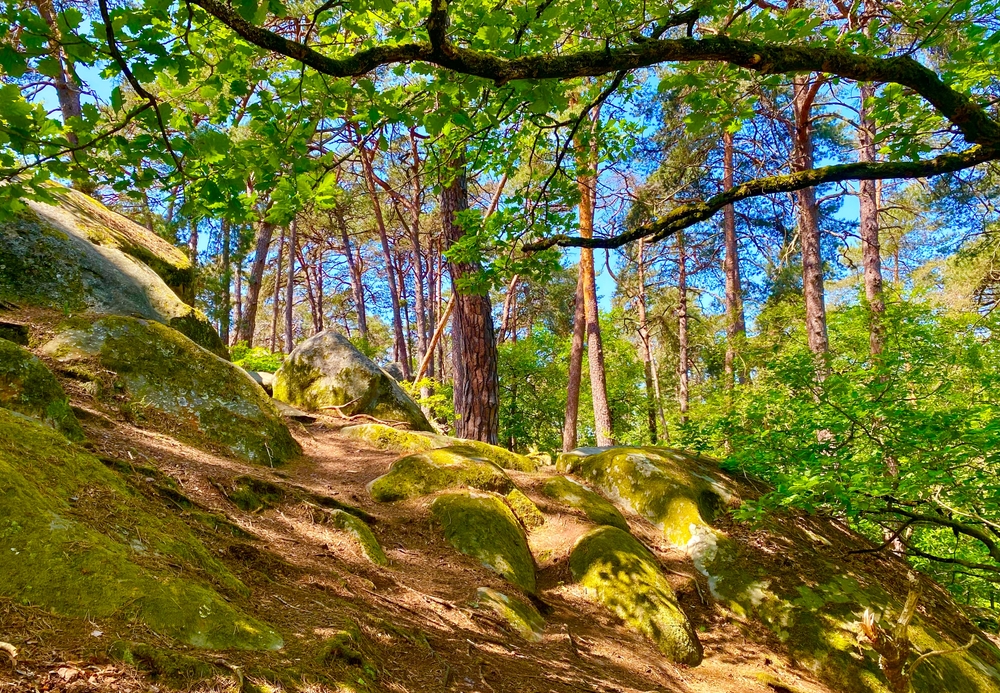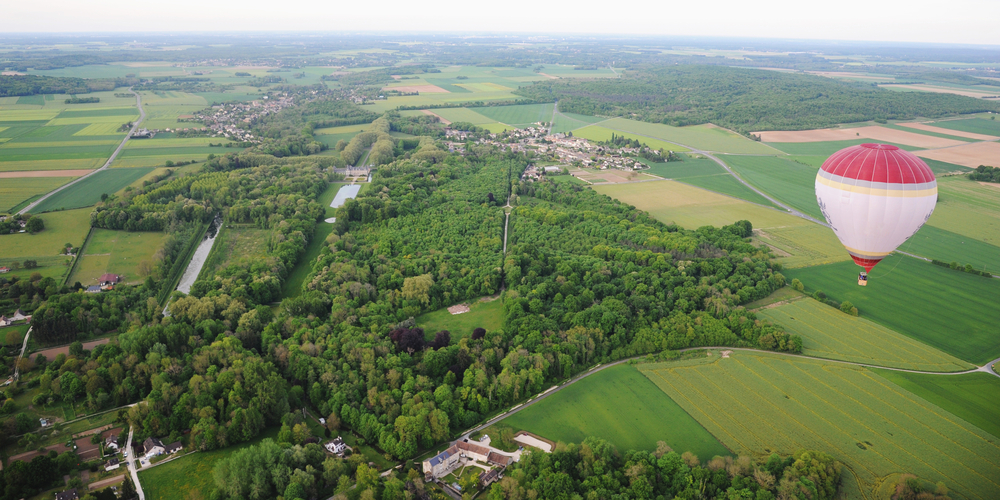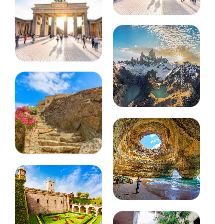The 10 most beautiful walks in the Forêt de Fontainebleau

The Forêt de Fontainebleau, a veritable natural gem just 70 kilometres south of Paris, offers walkers an exceptional playground. With its 25,000 hectares of unspoilt countryside, its sandstone rocks sculpted by erosion and its historic trails laid out by Denecourt in the 19th century, this legendary forest offers walks to suit all abilities. From family trails to the most technical, discover the 10 best walks in the Forêt de Fontainebleau.
200 audioguided tours for cities all around the world
DownloadSee also the Fontainebleau guide :
- 5 ideas for a romantic weekend near Paris
- The 12 most beautiful walks in Paris to discover
- The most beautiful villages to discover around Paris this winter
- Top 5 events in Paris
- Top 7 best hotels in Paris
1. The 25 Moguls circuit: The ultimate Three Gables challenge
Considered to be one of the most legendary hikes in the Paris region, the Circuit des 25 Bosses is a 17-kilometre sportive with over 800 metres of ascent. This red-marked loop crosses the Massif des Trois Pignons, to the west of the Fontainebleau forest, and offers breathtaking scenery.
The route generally starts at the Croix Saint-Jérôme car park, near Arbonne-la-Forêt. Experienced hikers will need between 5 and 7 hours to complete this technical route, which alternates between steep climbs through rocky chaos and spectacular descents. Each “bump” offers a unique panorama of the surrounding forest, with remarkable viewpoints such as Rocher de la Tortue and Mont Pivot.
Download the audio tour to discover Fontainebleau on foot and on your own
Although this sporting tour takes you to the gates of the imperial city, take time to discover Fontainebleau’s exceptional heritage with a guided tour. Explore the Château de Fontainebleau, the Imperial Theatre and the Denecourt Tower on an audio tour that will reveal all the secrets of this historic destination near Paris.
2. The Apremont Gorges via the Caverne des Brigands
This 6-kilometre walk is one of the most picturesque in the Forêt de Fontainebleau. The route, which is accessible to all abilities, starts at the Gorges d’Apremont car park and takes you through magical landscapes dotted with spectacular rock formations.
The route passes through the famous Caverne des Brigands, designed by Claude-François Denecourt, with two entrances linked by an underground passage. This man-made geological curiosity adds a mysterious dimension to the walk. The path then takes you to the Apremont Gorges themselves, offering breathtaking views of the rock formations sculpted by erosion.
On the way, stop off at the Chalet de la Caverne des Brigands for a bite to eat and enjoy the unique atmosphere of a place steeped in history. On this family-friendly walk, you can admire the three-hundred-year-old oak trees and discover the rich biodiversity of the forest.
3. The Barbizon circuit and the Tillaie reserve
Departing from the painters’ village of Barbizon, this 8-kilometre walk immerses you in the atmosphere that inspired the artists of the Barbizon School in the 19th century. The trail, used by Théodore Rousseau, Jean-Baptiste Camille Corot and Jean-François Millet, passes through landscapes of striking beauty.
The route runs alongside the Tillaie biological reserve, one of the oldest forest reserves in France, created in 1861. This protected area is home to exceptional biodiversity and offers a chance to observe the forest in its most natural state. The route is dotted with rocks of extraordinary shapes, including the famous “Barbizon Elephant”, a rock formation sculpted by erosion.
This walk offers a perfect balance between nature and culture, helping you to understand why this forest was such an inspiration to 19th-century landscape painters. Let yourself be guided along historic paths to discover these natural masterpieces that shaped French art.
4. The Forêt de Fontainebleau and Mont Aigu
Mont Aigu is an excellent introduction to hiking in Fontainebleau, particularly suitable for beginners and families. This 9.5-kilometre trail offers a moderate route with gradual climbs and panoramic views of the surrounding forest.
The route starts at the Faisanderie car park and takes path number 8 up to the summit of Mont Aigu. Along the way, you’ll discover the Platières du Houx, a vast expanse of rock polished by glacial erosion, offering a landscape that is unique in the Paris region. The trail also takes you to the Grotte du Serment, a natural geological curiosity carved out of sandstone.
From the top of Mont Aigu, the panorama takes in the whole of the Fontainebleau forest, offering a breathtaking view of this sea of green dotted with rocky outcrops. This family hike is the perfect introduction to the characteristic landscapes of the state-owned forest.
5. The Franchard Gorges and the Route Amédée
This 8-kilometre walk, accessible to all, takes you to the heart of the Gorges de Franchard, one of the most spectacular sites in the forest. The route, which takes around 3 hours, alternates between high rock walls and clear views of the canopy.
The route follows part of the Route Amédée, a former carriageway that has been converted into a hiking trail. The highlight of the walk is undoubtedly the Saint-Mégrin viewpoint, which offers an exceptional panorama of the gorge and surrounding forest. The rock formations create natural passageways and caves that will delight the youngest visitors.
At the end of the route, the walk skirts the Platières de Franchard Biological Reserve, a protected area where you can observe the natural evolution of the forest. This remarkable area is home to flora and fauna specific to rocky environments and is a veritable open-air laboratory for scientists.
6. Mont Merle via Rocher des Princes and Rocher des Étroitures
This 17-kilometre, 5-hour walk takes you through some of the wildest parts of the Fontainebleau forest. The relatively technical route passes through three remarkable areas: the Rocher des Princes, the Rocher des Étroitures and culminates at Mont Merle.
The route begins with a gradual ascent to the Rocher des Princes, an imposing rock formation with renowned climbing routes. The path continues towards the Rocher des Étroitures, a narrow passage between two rock walls that gives the site its name. These spectacular passages between the rocks create a mysterious and wild atmosphere.
Mont Merle, the highest point of this hike, lies at the heart of an integral biological reserve where nature evolves without human intervention. This protected area is home to a primeval forest with dead trees left in place, creating a habitat of choice for many species. The route also passes close to the Mare aux Fées, a natural waterhole that attracts a wide variety of wildlife.
7. The Croix du Calvaire, the Tour Denecourt and the Roche Éponge
This 7-kilometre trail, easily accessible from Fontainebleau-Avon station, takes in the main sights created by Claude-François Denecourt, the “Sylvain de Fontainebleau”. This heritage trail follows the blue-marked Denecourt-Colinet path no. 2 in its entirety.
The route begins with an ascent to the Croix du Calvaire, a monument erected in 1875 that marks one of the highest points in the forest. The trail continues on to the Tour Denecourt, a metal structure built in 1851 that offers an exceptional panoramic view of the town of Fontainebleau, its château and the Seine valley.
The Roche Éponge, discovered by Denecourt in 1866, is one of the forest’s most remarkable geological curiosities. This honeycombed rock formation, sculpted by erosion, has a unique texture that effectively evokes a giant sponge. The route also takes in the Quatre Fontaines and the Grotte Colinet, testimony to the development work of this 19th-century visionary.
8. From Fontainebleau to Bois-le-Roi through the forest

This 12-kilometre walk links two SNCF stations and passes through some of the most beautiful parts of the national forest. The route, which can be explored on foot or by mountain bike, offers total immersion in the diversity of the Bellifont landscape, alternating between dense forest and rocky clearings.
The route starts in the centre of Fontainebleau and quickly moves into the forest via the historic paths. The itinerary allows you to observe the remarkable diversity of forest species: sessile and pedunculate oaks, beeches, birches, Scots pines and maritime pines planted in the 19th century.
One of the highlights of this walk is the discovery of the Roche Éponge, a unique geological formation characterised by mineral cavities carved out by differential erosion. This natural curiosity is a perfect illustration of the geological processes at work in this forest on a plateau of Fontainebleau sandstone.
9. The Belvedere Trail – Panoramic route
This 8.5-kilometre hike has been specially designed to offer some of the finest panoramic views in the Forest of Fontainebleau. The Sentier des Belvédères links six remarkable viewpoints, each offering a unique perspective on the forest and rocky landscapes.
The route begins at the Épine crossroads and gradually climbs to the heights of the forest. The first viewpoint offers a bird’s-eye view of the rocky chaos of the Gorges d’Apremont, while the second allows you to take in the entire Seine valley as far as the Champagne hills on a clear day.
The route passes through several biotopes characteristic of the Fontainebleau forest: dry moorland on the sandstone plateaux, beech forests on the cool slopes and mixed oak forests in the valleys. This diversity of habitats explains the exceptional richness of the forest flora and fauna, making Fontainebleau a veritable conservatory of the Ile-de-France region’s biodiversity.
10. The Rocher Canon and Platières circuit
This final 10-kilometre hike takes you to one of the wildest and best-preserved parts of the Fontainebleau forest. The Rocher Canon trail passes through stunningly beautiful landscapes, alternating between spectacular rocky chaos and vast plains polished by glacial erosion.
The route starts at the Rocher Canon car park and leads into a dense forest dominated by centuries-old oaks. The path climbs steadily towards the rock formations that give the route its name. The Rocher Canon, an imposing rock bar several hundred metres long, offers renowned climbing walls and panoramic views over the canopy.
The Platières, vast stretches of polished sandstone, are one of Fontainebleau’s most distinctive landscapes. These rocky surfaces, veritable natural slabs, create a unique environment where specialised plant species flourish. At flowering time, these areas are decked out in dazzling colours with heather, broom and wild orchids.
Let Navaway guide you through this exceptional forest, revealing all the secrets of this unique natural heritage. Whether you’re a geology or botany enthusiast, or simply a lover of beautiful landscapes, Fontainebleau’s walks will win you over with their diversity and rich heritage.
In conclusion, the Forêt de Fontainebleau offers an exceptional range of walks to suit all tastes and abilities. From the legendary Circuit des 25 Bosses to the family-friendly walks of the Gorges d’Apremont, each trail reveals a different facet of this natural jewel of the Paris region. These 10 walks will take you through landscapes of striking beauty, witness to millions of years of geological evolution and centuries of forest management. Take advantage of your stay to visit Fontainebleau and discover its exceptional historical heritage, the perfect complement to these unforgettable natural escapades.
FAQ – Hiking in the Forêt de Fontainebleau
When is the best time to walk in Fontainebleau?
The forest of Fontainebleau can be visited all year round, but the best periods are spring (April-May) for the flowers and autumn (October-November) for the colours. Avoid busy weekends in summer and hunting seasons in autumn.
How do I get to the Fontainebleau forest from Paris?
By train: Transilien line R from Gare de Lyon to Fontainebleau-Avon (40 minutes). By car: A6 motorway, exit 13 Fontainebleau or N7 (1 hour from Paris). Numerous free car parks are available at the main starting points for the walks.
Do I need special equipment to hike in Fontainebleau?
Good walking shoes essential on rocky terrain, weather-appropriate clothing, water and snacks. For difficult circuits such as the 25 Bosses: hiking poles recommended, IGN map or GPS, sun protection for passages on rocky plains.
Can you hike with children in the forest of Fontainebleau?
Yes, several routes are suitable for families: Gorges d’Apremont (6 km), Mont Aigu (short version), short Denecourt trails. Choose the signposted routes, allow more time with the children, and beware of the rocky sections which can be slippery.
200 audioguided tours for cities all around the world
Download
